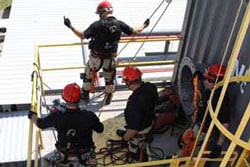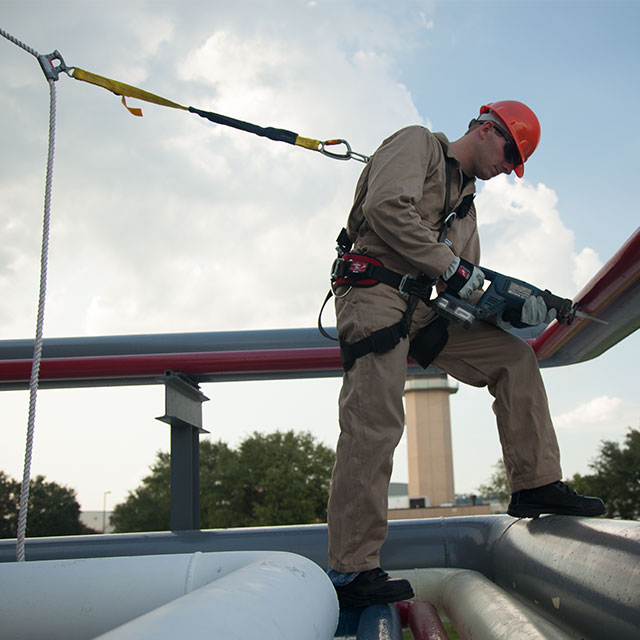By Pat Furr, VPP Coordinator & Corporate Safety Officer for Roco Rescue, Inc.

At the start of nearly every rescue class, I'll ask, “Okay, who here is afraid of heights?” Usually a few folks will raise their hands, but the vast majority don’t. I then qualify the same question by saying, “By afraid, I don’t mean that you are so overcome with fear that you cannot function – only that when you are at height you get a little case of the butterflies…” Then a few more hands will go up, but typically still fewer than half the class. I continue by adding that I’m always am a bit concerned for the folks that didn’t raise their hand as it means one of two things. First, it may be they are not being totally honest, but more concerning to me is they truly are not afraid of heights...and this is scary.
 Human beings are born with an innate fear of heights. This is natural, and quite protective. I’m certainly afraid of heights, and I still get butterflies. It’s just that I’ve learned how to get those butterflies to fly in formation, so I can then function just fine at height. The day I climb atop a wind turbine tower or get that first peek over the edge of some serious exposure, and I don’t get that familiar feeling, that’s my sign to hang up my harness and ride the keyboard full time. This feeling is our not-too-subtle reminder that we do not have wings…and it is a healthy reminder!
Human beings are born with an innate fear of heights. This is natural, and quite protective. I’m certainly afraid of heights, and I still get butterflies. It’s just that I’ve learned how to get those butterflies to fly in formation, so I can then function just fine at height. The day I climb atop a wind turbine tower or get that first peek over the edge of some serious exposure, and I don’t get that familiar feeling, that’s my sign to hang up my harness and ride the keyboard full time. This feeling is our not-too-subtle reminder that we do not have wings…and it is a healthy reminder!
There is a point to this, and I’m about to get there. Over the years, I've had some students with a serious case of YMIC (young male immortality complex). They will insist that they are not afraid of heights – or anything else, for that matter. I've found, when it comes time to go over the edge while hanging from that skinny little ½” kernmantle rope, backed up with a ½” safety line, our superheroes tend to freeze like the statue of Michelangelo. They won’t budge, can’t speak, or look any direction but down! Most often, these individuals gradually gain trust in their equipment; in the techniques they’ve learned; and perhaps, most importantly, in themselves. While they may never be "comfortable" going over the edge, they can still be valuable members of their rescue team. Some can be very strong in many other rescue skills such as knot tying, rigging, friction control, mechanical advantage, etc. They can also be excellent in logistics, developing action plans and other key areas.
First, know your weaknesses as well as your strengths. Then, identify your weaknesses and strive to make them your strengths.
A second tenet I live by is to enter a rescue knowing that you will be an asset to the effort. But sometimes, it’s not possible to do this, and having an unusual fear of heights may be one of those times. Avoid crossing the line from being an asset to becoming a liability – creating a situation in which your team would then have to deal with “two” victims. This is huge – especially in an emergency. And that’s what this article is all about.
Before I go any further, a bit about egos. There is simply no room for egos during a rescue. When the call comes in, it’s about one person and one person only, and that is the victim. We all have our pride, but we need to “park it” until everyone, including the victim and the rescuers, are safe and sound. As trained rescuers, we all have something to contribute. Each of us has a role to fill in the rescue effort and be an asset to the overall effectiveness of our team.
 So, how do we learn what our best role as a rescuer may be? Here’s one way. Practice as a team in simulated rescues that are scenario driven and mimic the types of rescues that your team may be summoned to perform. It is during these practice sessions that you will discover your strengths and your weaknesses. It is important for ALL team members to honestly critique each other as well as themselves to help determine the best way to fill the different roles on the team.
So, how do we learn what our best role as a rescuer may be? Here’s one way. Practice as a team in simulated rescues that are scenario driven and mimic the types of rescues that your team may be summoned to perform. It is during these practice sessions that you will discover your strengths and your weaknesses. It is important for ALL team members to honestly critique each other as well as themselves to help determine the best way to fill the different roles on the team.
As your team practices more often, trends will start to surface. One rescuer may be particularly strong at climbing and can rig cleanly and efficiently while hanging from work positioning equipment. Another rescuer may be your “ace in the hole” for rigging anchors. A third may be so good at converting lowering systems to haul systems, that it’s an obvious choice. Then, there may be some that don’t shine at any particular skill, but are reliable haul team members or can run the SAR cart with the best of them.
 All teams have a spectrum of performers, whether it’s a football team, a production assembly line or a team of cooks and chefs in a large restaurant. The same holds true for a rescue team. Some of the factors that affect performance may be physical. Let’s face it, our 5’4” 150-pound “Hole Rat” can pass through tight portals and operate in congested confined spaces easier than most 6’ 6” 280-pounders. Sometimes it’s mechanical aptitude. We see it all the time in training rescuers. Some folks have a natural mechanical aptitude and can understand and build rescue systems as if it were second nature, while others struggle to get it right on a consistent basis.
All teams have a spectrum of performers, whether it’s a football team, a production assembly line or a team of cooks and chefs in a large restaurant. The same holds true for a rescue team. Some of the factors that affect performance may be physical. Let’s face it, our 5’4” 150-pound “Hole Rat” can pass through tight portals and operate in congested confined spaces easier than most 6’ 6” 280-pounders. Sometimes it’s mechanical aptitude. We see it all the time in training rescuers. Some folks have a natural mechanical aptitude and can understand and build rescue systems as if it were second nature, while others struggle to get it right on a consistent basis.
 And, yes, a pronounced fear of height that may inhibit a rescuer’s ability to perform effectively at height is yet another factor to consider. Other things include leadership qualities, attention to detail, general physical strength, comfort with breathing air systems, the presence or lack of claustrophobia and the list goes on. The only way to realize and understand these abilities and limitations is to practice as a team – and practice often – while staying attuned to these individual abilities and limits. Understand them and use them to your advantage in determining who is the best fit for the various team member roles on any given rescue effort. And please, please do not take it personally. Again, we all have our pride and want to shine; however, we all can shine as a team! And the best way to shine as a team is to understand, as best we can, where each member best fits and can contribute most.
And, yes, a pronounced fear of height that may inhibit a rescuer’s ability to perform effectively at height is yet another factor to consider. Other things include leadership qualities, attention to detail, general physical strength, comfort with breathing air systems, the presence or lack of claustrophobia and the list goes on. The only way to realize and understand these abilities and limitations is to practice as a team – and practice often – while staying attuned to these individual abilities and limits. Understand them and use them to your advantage in determining who is the best fit for the various team member roles on any given rescue effort. And please, please do not take it personally. Again, we all have our pride and want to shine; however, we all can shine as a team! And the best way to shine as a team is to understand, as best we can, where each member best fits and can contribute most.
Remember, so much of rescue is about mechanical systems, safety, victim packaging and other easily defined considerations. As rescuers, I invite you to take it to the next level. Think about the harder-to-define factors such as individual team member skills AND limitations. Help each other as a team arrive at the best mix of the right people in the right positions – and all for the good of the victim!



 Here’s one early sign that complacency is creeping in – you find yourself distracted while performing your job. This applies not only to individual workers, but in a more global sense can happen within the company culture. When worries start to crop up, be it individual workers, or within management, the focus may center on issues other than the task at hand. When you feel this happening, stop and evaluate whether you are paying the required attention to the task at hand; and if you are not, what could the possible consequences be? Think worst case, because that is quite likely the end result!
Here’s one early sign that complacency is creeping in – you find yourself distracted while performing your job. This applies not only to individual workers, but in a more global sense can happen within the company culture. When worries start to crop up, be it individual workers, or within management, the focus may center on issues other than the task at hand. When you feel this happening, stop and evaluate whether you are paying the required attention to the task at hand; and if you are not, what could the possible consequences be? Think worst case, because that is quite likely the end result! I like to call my TV set a “one-eyed-brain sucker,” and fondly refer to my cell phone as a “hand-held brain sucker.” There is a time and a place for it – and, yes they are very valuable, but if you find it has any chance of distracting you from your work and can be the cause of an unsafe condition, tighten up, don’t be complacent! Put that cell phone away until you can use it safely.
I like to call my TV set a “one-eyed-brain sucker,” and fondly refer to my cell phone as a “hand-held brain sucker.” There is a time and a place for it – and, yes they are very valuable, but if you find it has any chance of distracting you from your work and can be the cause of an unsafe condition, tighten up, don’t be complacent! Put that cell phone away until you can use it safely.
 There are several roles and responsibilities within any comprehensive fall protection program, and there are just as many courses of instruction that provide a baseline of knowledge and skills designed to get the individuals occupying these positions started or to enhance their ability to perform in these roles. But no single course of instruction currently covers, nor will one ever cover, every bit of knowledge needed for every work at height situation.
There are several roles and responsibilities within any comprehensive fall protection program, and there are just as many courses of instruction that provide a baseline of knowledge and skills designed to get the individuals occupying these positions started or to enhance their ability to perform in these roles. But no single course of instruction currently covers, nor will one ever cover, every bit of knowledge needed for every work at height situation.
 Sharing Lessons Learned
Sharing Lessons Learned The following article was featured in the June 2014 issue of ISHN, and authored by Roco Chief Instructor Pat Furr.
The following article was featured in the June 2014 issue of ISHN, and authored by Roco Chief Instructor Pat Furr.
 Time to Train
Time to Train


